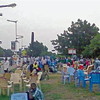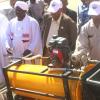Sudan faces up to reality of floods and droughts
Rain shortages, desertification and torrential floods is hurting Sudanese agriculture and has sparked a probe by the government.
The ministry looks at the rainfall issue in terms of quantity and distribution because rains are sometimes abundant — but not where the rains are most needed,” says Adel Yusuf Tayeb, who heads the rain section at the Ministry of Agriculture in Sudan.
Using modern methods, Sudan provides forecasts and guidelines for agriculture. This year, for example, autumn is expected to see above average rainfall levels in the states of Kordofan, Gedaref, Kassala and Gezira.
When the weather forecast tells about scarcity or torrential rains, agriculture chooses a crop that suits the forecasted rain pattern.”The Sudan Meteorological Authority, according to its website, provides weather-related services for the agricultural sector for example, forecasts and suggesting crops and livestock suitable for the environmental conditions. It also carries out experiments on the impact of current climatic conditions and issues early warnings on tornadoes, hail, frost, extreme heat and floods.
When the weather forecast tells about scarcity or torrential rains, agriculture chooses a crop that suits the forecasted rain pattern,” Tayeb says. In the event of drought, we plant corn varieties characterised by their rapid growth and resistance to water scarcity. But then the yield will be small compared with the varieties grown during heavy rainfall.”
Abdul Hamid Adam Mokhtar, Secretary General of the Sudanese Farmers Union, underlines the value of these forecasts. When we receive a report from the Meteorological Authority that rains are scanty or heavy in a given year, we use improved seed varieties that are resistant to drought or specially developed techniques to tackle heavy rainfall.”
One recent method to address climatic change is water-harvesting which, according to Abdul Hamid, has efficiently contributed to resolving the problem of drought and minimised the seasons with scant rain.”
When forecasts predict a low level of rainfall, fields are prepared to draw up water, thus tapping into rain falling in other places. This technique is part of the United Nations Food and Agriculture Organisation’s (FAO) pilot projects, which are being implemented now in the states of Sinnar, White Nile and Kordofan.
Farmers mostly depend on their intuition to determine autumn weather and its success.”But despite all the techniques used by the Sudanese Ministry of Agriculture, there is still a long way to go, according to Salah Qarnas, an Agronomist. Seeds treatment and adaptation to the climate is the only scientific method available for Sudan at present,” he says, adding that rain-fed cultivation may fail even if it used drought resistant seeds as there might be less rainwater than needed.
And while the modern forecasting helps, most farmers use their experience to deal with the rainy season. The ideal time for cultivation is the first week of July because when rain falls at that time, it creates humidity that helps the growth of certain crops.
Farmers mostly depend on their intuition to determine autumn weather and its success,” says farmer Salem Adam Hammad, adding that they tend to know how the autumn harvest will fare after just one week.





